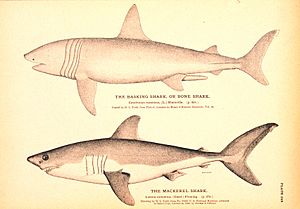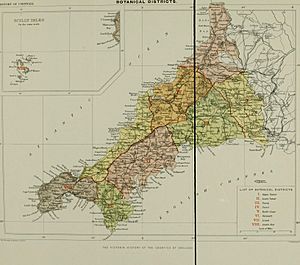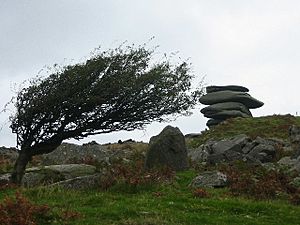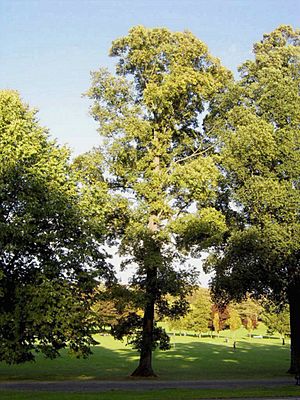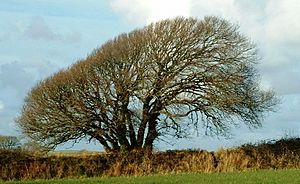Flora and fauna of Cornwall facts for kids
Cornwall is a county at the very tip of England's southwestern coast. It has a mild and warm climate thanks to the Gulf Stream, a warm ocean current. This mild weather helps many different plants grow, including palm trees in the far south and west, and on the Isles of Scilly. These areas have almost sub-tropical conditions in summer.
On Cornwall's high moors and hills, strong winds make it hard for tall trees to grow. Instead, you'll find shrubs and bushes like gorse and heather. You can also spot Ferns, mosses, liverworts, lichens, and fungi all over the county. In the wettest parts of Bodmin Moor, a special type of sphagnum or bog moss can be found.
Cornwall is home to many rare flowers, especially at the southern end of the Lizard Peninsula. This is because of its special soil and rocks. On the Lizard, you can find Cornish heath, which is Cornwall's official flower. Other plants include mesembryanthemums, butcher's broom, early meadow grass, and many types of clovers, like the unique Lizard clover. The north coast of Cornwall has grassland near the sea, heathland, and small, twisted woodland areas.
In the past, during medieval times, royal families and bishops had special deer parks. These parks held fallow deer for hunting. Many of these parks were later turned into pastures for cattle around the year 1540 by King Henry VIII.
Contents
Amazing Coastal Animals
The waters around Cornwall are full of life! You can often see large groups of seals. It's also common to spot porpoises, whales, and sharks.
Porbeagle sharks live in these coastal waters. Their name is a bit of a mystery! Some people think it combines "porpoise" (a type of small whale) and "beagle" (a dog), because of the shark's shape and how it hunts. Others think it comes from the Cornish language words porth (meaning "harbour") and bugel (meaning "shepherd").
Swanpool is a special lake in Cornwall. It's the only place in the whole of the British Isles where a tiny water animal called Victorella pavida lives.
Wildlife on Cliffs, Rivers, and Estuaries
Cornwall's sea cliffs are home to many kinds of sea birds. The red-billed chough, a rare bird, has recently returned to Cornwall after being away for a long time. This special bird is even on the Cornish coat of arms and is the county's official animal! It's a type of crow with a bright red beak and legs.
The tidal estuaries (where rivers meet the sea) along the coast are home to many wading birds. Inland, marshland areas and bogs attract different kinds of marsh birds. Bodmin Moor is a breeding spot for birds like lapwings, snipes, and curlews.
Along the rivers, you can often see sand martins and kingfishers. After a big drop in numbers in the 1960s and 70s, Eurasian otters are now returning to Cornwall in large numbers. The Camel Valley is one of their favorite places. The Bude Canal is a great home for water voles, though their numbers are going down because of pollution and changes to their habitat.
The Mousehole Wild Bird Hospital and Sanctuary is a special place near Mousehole that helps injured birds. It became famous after the Torrey Canyon disaster in 1967, when many birds were hurt by an oil spill. The Cornish Seal Sanctuary in Gweek was started in 1958 and helps injured seal pups.
The Tamar Valley: A Special Place for Nature
The Tamar Valley is a beautiful area that has been named an Area of Outstanding Natural Beauty. It covers about 195 square kilometers (75 sq mi) around the lower part of the River Tamar and its smaller rivers, the Tavy and the Lynher. This area was officially protected in 1995.
The Tamar Otter and Wildlife Centre (which is now permanently closed) used to be a home for European and Asian short-clawed otters. It also had a duck pond and a nature trail where you could see snowy and barn owls, along with other birds. The trail was full of wildlife like fallow and muntjac deer, peacocks, and even wallabies! There was also a waterfall coming down from an old quarry.
The Lizard Peninsula: A Unique Habitat
The Lizard Peninsula has several important nature sites, including Predannack nature reserve, Mullion Island, Goonhilly Downs, and the National Seal Sanctuary at Gweek. It's also one of the few places in England where the rare red-billed chough breeds. This type of crow, with its bright red beak and legs and a special "chee-aw" call, started breeding on the Lizard again in 2002. This happened thanks to a big effort by the Cornish Chough Project, working with DEFRA and the RSPB.
The Lizard has some of the most unique plants in Britain, including many rare species listed in the Red Data Book. The Cornish heath is especially important because it grows in large amounts here but nowhere else in Britain. It's also one of the few places where you can find the rare formicine ant called the narrow-headed ant.
South Coast Wildlife
At Polruan, the gorse-covered cliffs facing south between Polruan and Polperro are perfect homes for birds like the goldfinch, yellowhammer, and stonechat. You can also find reptiles like the slowworm and the adder, which are quite common here.
The marine life in these waters is amazing! Basking sharks have even been known to swim into the harbour. In 1972, a very large basking shark, longer than the width of the quay, was seen at Polruan Quay. Other fish you might find in the local waters and estuary include bass, wrasse (four types!), seahorse, pipe fish, pollock, coalfish, flounder, plaice, conger eel, European eel, dragonet, red gurnard, grey gurnard, blenny (shanney), bullhead, burbot, butterfish, sand-eel, salmon, sea trout, garfish, mackerel, angler fish (also called "monk fish" in restaurants), dab, whitebait, scad (horse mackerel), shad, herring, turbot, pouting, poor cod, and rockling.
The Isles of Scilly: A Haven for Plants and Birds

Because of the warm Gulf Stream, the climate on the Isles of Scilly is very mild. This allows sub-tropical plants, including real palm trees, to grow there. The Scilly Isles are also the first stop for many migrant birds flying across the Atlantic, including very rare birds from North America and Siberia. Since the islands are far out in the ocean, many birds that get lost on their way from North America will land here first in Europe.
The Scilly Isles are famous for being the first place in Britain where many rare birds have been spotted. If a super rare bird shows up, the islands will quickly fill with many birdwatchers!
Cornwall's Flora (Plants)
Botanists (scientists who study plants) divide Cornwall and the Isles of Scilly into two main plant areas: West (1) and East (2). The line between them runs from Truro to Wadebridge.
A very important book about Cornwall's plants is Flora of Cornwall (1909) by Frederick Hamilton Davey. He listed all the plants reported in Cornwall from 1576 up to his time. The Isles of Scilly are also covered, but a more detailed book for them is by Job Edward Lousley. Many other books and supplements have been written since then, adding to our knowledge of Cornish plants.
Another helpful book is The Flowers of the Field (1853) by Charles Alexander Johns. He was from Cornwall and knew a lot about its plants and animals. He also wrote A Week at the Lizard (1848), which drew attention to the unique plants of the Lizard Peninsula.
- Plants around Tintagel
Near Tintagel, you can find at least 385 different types of flowers, 30 kinds of grasses, and 16 types of Ferns. It's a great place for plant lovers!
Cornish Plant Symbols
The official flower of Cornwall is said to be either broom, furze (gorse), rhododendron, or Cornish heath. The Cornish national tree is the sessile oak, which is known locally as the Cornish oak.
Thrift (Armeria maritima) was chosen as the "county flower" for the Isles of Scilly in 2002 by a plant conservation group called Plantlife.
Beautiful Botanic Gardens
Cornwall and the Isles of Scilly have several amazing botanic gardens. These include the Eden Project, the Lost Gardens of Heligan, and Trebah. On the Isles of Scilly, you can visit Tresco Abbey Gardens.
The "monkey puzzle tree" (Araucaria araucana) got its funny name from a tree at Pencarrow. Someone once said, "It would puzzle a monkey to climb that!" and the name stuck!
Gardening in Cornwall
Cornwall's climate is so special that it allows gardeners to grow a huge variety of plants. Gardeners in Cornwall and Devon helped plant collectors by carefully looking after new seedlings. They even extended their gardens into woods to create the perfect growing conditions. Some plants, like Rhododendron macabeanum, can grow even bigger in Cornwall than in their native homes!
Many of Cornwall's famous gardens are near the coast, where the climate is milder and there's more rain. Protecting plants from the wind is very important, especially near the sea. Trees like Monterey pine, sycamore, and ash are good for creating windbreaks. Most of the soil in Cornwall is acidic and full of rich leaf mould, which many plants love. Rhododendrons, both wild types and special ones created by gardeners like 'Cornish Cross' and 'Penjerrick', grow especially well here. Plants from South America, such as Crinodendrons and Embothrium coccineum, also thrive.
Many old church gardens in Cornwall are also very beautiful and varied. Some are large enough for planting many trees and have both formal and natural areas.
Cornwall's Special Trees
The Darley Oak is an ancient oak tree near Darleyford on the edge of Bodmin Moor. This tree is thought to be at least 1,000 years old, and many local legends are told about it.
Elm Trees
The Cornish Elm
The Cornish Elm used to be very common in Cornwall, but now it's mostly found outside the county. No one is quite sure how it first arrived in the UK. Some think people brought it from Brittany, while others believe it might have survived the ice ages on land that is now under the sea south of Cornwall. The tree was traditionally chosen to provide shelter along the Cornish coast because it was so strong. Its wood was also highly valued for building wheels and wagons.
The Davey Elm
The Davey Elm (Ulmus × hollandica 'Daveyi') is a type of elm tree mostly found in the valleys of Cornwall. It's thought to be a hybrid (a mix) of the wych elm and the Cornish Elm.
Fruit Trees
Cornwall is home to several unique types of fruit trees, especially apples!
- Cornish Aromatic
The Cornish Aromatic is an apple with a crisp, nutty, and fragrant taste. It was first recorded in Cornwall in 1813.
- Cornish Gilliflower
The Cornish Gilliflower apple was found in Truro, Cornwall, around 1800. Its name comes from a French word meaning "clove," probably because of its spicy smell. This apple became popular with growers in 1813.
- Dufflin
Dufflin is an old type of cider apple from Cornwall.
- Hocking's Green
This apple variety comes from Coad's Green in Cornwall.
- King Byerd
The King Byerd is a Cornish cultivar (a type grown by people) of apple. It produces many large fruits that are good for both cooking and eating fresh. They are harvested from late October.
- Kea Plum
The Kea Plum is a type of plum similar to a damson, and it gets its name from the parish of Kea.
Cornwall's Natural Symbols
| Title | Symbol | Picture |
|---|---|---|
| Subnational tree | Cornish Elm (Ulmus minor stricta) |  |
| Subnational flower | Spring Squill (Floral Emblem of Kernow) |  |
| Subnational bird | Cornish Chough/Red-billed Chough (Pyrrhocorax pyrrhocorax) | |
| Subnational animal | European rabbit (Oryctolagus cuniculus) |  |
| Subnational fruit | Cornish Gilliflower (Malus domestica) | |
| Subnational vegetable | Collard (plant) (Brassica oleracea) | |
| Subnational crop | Potato (Solanum tuberosum) |  |
Other Special Cornish Plants
The Cornish heath (Erica vagans) is found only on the Lizard Peninsula and is recognized as Cornwall's floral emblem.
In recent years, daffodils have become popular during the annual Saint Piran's Day march on Perran Sands. These flowers are donated by a local daffodil grower, even though the daffodil is already the national flower of Wales.
As part of a campaign in 2002, the plant conservation charity Plantlife chose Thrift (Armeria maritima) as the "county flower" of the Isles of Scilly.
The Cornish eyebright (Euphrasia vigursii) grows on heathland in Cornwall and south Devon.
The Cornish moneywort (Sibthorpia europaea) is found in parts of south-west England, Wales, and southern Ireland.
Cornish path-moss (Ditrichum cornubicum) was discovered in 1963 at Lanner.
The Least adder's-tongue (Ophioglossum lusitanicum) is a rare plant in Britain, found only in a small coastal heath area on St Agnes, Isles of Scilly. It grows in short grass on Wingletang Downs, but some groups are struggling because of too many competitive grasses, gorse (Ulex europaeus), and bramble (Rubus fruticosus).
"Cornish palm" is a local name for the Cordyline australis tree, which originally comes from New Zealand.




